| Questions |
Answers |
| 16. What are the special aspects of the "Nutrition
Facts" labels for products intended for infants and small children?
|
"Nutrition Facts" labels for foods specifically for children less
than 4 years do not present % Daily Value or footnotes as used on general
food supply labels. Also, foods specifically for children less than 2
years of age must not present information on calories from fat and
calories from saturated fat and quantitative amounts for saturated fat,
polyunsaturated fat, monounsaturated fat and cholesterol. In both cases,
% Daily Value is declared only for protein, vitamins, and minerals.
Fruit dessert for children
less than 2 years old
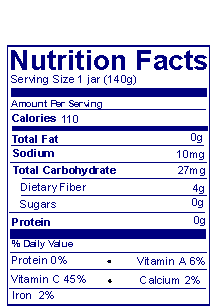
|
Fruit dessert for children
ages 2 years to 4 years
|
| 21 CFR 101.9(j)(5)(i) |
21 CFR 101.9(j)(5)(ii) |
|
| 17. Which nutrients may be summarized in a
sentence after the vitamin and mineral listing instead of showing
"0 g" on the "Nutrition Facts" label? |
The nutrients listed below may be omitted from the list of nutrients
and included in a single sentence when present at "zero" levels in a
food. This is done by putting the label statement ("not a significant
source of _________") immediately below the listing of vitamins A and C,
calcium, and iron.
| Nutrient |
Level per serving |
Label statement |
Calories from fat
21 CFR 101.9(c)(1)(ii) |
Less than 0.5 g fat |
"Not a significant source of calories from fat" |
Saturated fat
21 CFR 101.9(c)(2)(i) |
Less than 0.5g of total fat |
"Not a significant source of saturated fat" |
Cholesterol
21 CFR 101.9(c)(3) |
Less than 2 mg |
"Not a significant source of cholesterol" |
Dietary fiber
21 CFR 101.9(c)(6)(i) |
Less than 1g |
"Not a significant source of dietary fiber" |
Sugars
21 CFR 101.9(c)(6)(ii) |
Less than 1g |
"Not a significant source of sugars" |
Vitamins A and C, calcium, and iron
21 CFR 101.9(c)(8)(iii) |
Less than 2% of RDI |
"Not a significant source of _________" (listing the vitamins
or minerals omitted) |
|
| 18. Is there a "Nutrition Facts" format
for a food in which most nutrients are present in insignificant
amounts? |
 A simplified "Nutrition Facts" label may be used if at least seven of
the following nutrients are present in insignificant amounts: Calories,
total fat, saturated fat, cholesterol, sodium, total carbohydrate,
dietary fiber, sugars, protein, vitamin A, vitamin C, calcium and iron
(slightly different rules for labeling foods intended for children
less than 2 years). The five core nutrients, shown in bold in the
adjoining example, must always appear on all "Nutrition Facts" labels
regardless of amounts present in the food. In addition, any of the
nutrients required on the full "Nutrition Facts" label that are naturally
present or are added to the food must be
"declared on the simplified
"Nutrition Facts" label.
A simplified "Nutrition Facts" label may be used if at least seven of
the following nutrients are present in insignificant amounts: Calories,
total fat, saturated fat, cholesterol, sodium, total carbohydrate,
dietary fiber, sugars, protein, vitamin A, vitamin C, calcium and iron
(slightly different rules for labeling foods intended for children
less than 2 years). The five core nutrients, shown in bold in the
adjoining example, must always appear on all "Nutrition Facts" labels
regardless of amounts present in the food. In addition, any of the
nutrients required on the full "Nutrition Facts" label that are naturally
present or are added to the food must be
"declared on the simplified
"Nutrition Facts" label.
21 CFR 101.9(f) - List of nutrients, 101.9(f)(1) - "Insignificant"
defined, 101.9(c) - "Insignificant" levels listed for nutrients |
| 19. When should a statement be used on simplified
format labels to list nutrients present at insignificant
amounts? |
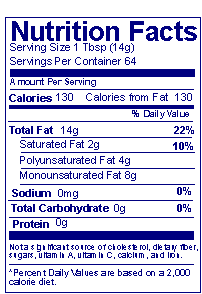 A "simplified format label" must include a statement listing "zero"
level nutrients when nutrients are added to the food or voluntarily
declared on the "Nutrition Facts" label, and when claims are made on
the label. In this example, the manufacturer voluntarily lists
polyunsaturated and monounsaturated fat, and therefore must add the
statement "Not a significant source of _________" with the blank filled
in by the names of nutrients present at insignificant levels.
A "simplified format label" must include a statement listing "zero"
level nutrients when nutrients are added to the food or voluntarily
declared on the "Nutrition Facts" label, and when claims are made on
the label. In this example, the manufacturer voluntarily lists
polyunsaturated and monounsaturated fat, and therefore must add the
statement "Not a significant source of _________" with the blank filled
in by the names of nutrients present at insignificant levels.
21 CFR 101.9(f)(4) |
| 20. What other nutrients can be declared on
the "Nutrition Facts" label? |
In addition to the nutrients shown on the label in #15
(in chapter V, first part)
manufacturers may add calories from saturated fat, or polyunsaturated
fat, monounsaturated fat, potassium,
soluble and insoluble fiber, sugar alcohol,
other carbohydrates, vitamins and minerals for which RDI's have been
established, or the percent of vitamin A that is present as beta-carotene.
21 CFR 101.9(c) |
| 21. Is there a restriction against certain
nutrients on the "Nutrition Facts" label? |
Only those nutrients listed in FDA's nutrition regulations, as
mandatory or voluntary components of the nutrition label, may be
included in the "Nutrition Facts" label.
21 CFR 101.9(c) |
| 22. When must voluntary nutrients be listed?
|
In addition to the nutrients shown on the sample labels in this
booklet, other nutrients (listed in FDA's regulations, e.g., thiamin)
must be included on a food's "Nutrition Facts" label if the nutrients are
added to the food, if the label makes a nutrition claim (such as a nutrient
content claim) about them, or if advertising or product literature
provides information connecting the nutrients to the food.
21 CFR 101.9(a), 101.9(c), 101.9(c)(8)(ii), & 101.9(c)(8)(ii)(A)-(B)
|
| 23. When should the vitamins and minerals in
flour be listed on the "Nutrition Facts" label? |
Generally, FDA only requires that the label declare the vitamins A
and C, and the minerals calcium and iron. The other enrichment vitamins
and minerals must be declared when they are added directly to the
packaged food (e.g., enriched bread), but not when the enriched product
is added as an ingredient to another food.
NOTE: It is necessary to declare the other vitamins and minerals in the
ingredient list. However, if unenriched flour is used, and the enrichment
nutrients are added separately, those nutrients (i.e., thiamin,
riboflavin, niacin, and folic acid)
would have to be declared on the "Nutrition Facts" label.
21 CFR 101.9(c)(8)(ii)(A)-(B), & 101.9(c)(8)(iv) |
| 24. What terms must be used for the
serving size?
| The serving size declaration is made up of two parts: a "household
measure term" followed by its metric equivalent in grams (g). For
beverages, the household measures may be declared as either fluid
ounces, cups, or fractions of a cup with the metric equivalent in
milliliters (mL). The examples below show permitted declarations.
| Food |
Examples |
| Cookies |
"1 cookie (28 g)" or "1 cookie (28 g/1 oz)" |
| Milk, juices, soft drinks |
"8 fl oz (240 mL)," or "1 cup (240 mL)" for
multiserving containers, or the container (e.g., "1 can")
for single serving containers |
| Grated cheese |
"1 tablespoon (5 g)" or "1 tablespoon (5 g/0.2 oz) |
21 CFR 101.9(b)(2), 101.9(b)(5), 101.9(b)(7), & 101.12(b) |
| 25. Is a "reference amount" different
from a serving size? |
Yes, the reference amount is used to derive a serving size for a
particular product. The following example shows how to use the reference
amount to determine the serving size for a 16 oz (454g) pizza:
Therefore, the serving size is "1/3 pizza (151g)" for this example,
whereas the reference amount is 140g for all pizzas.
Note: Sections 101.9(b)(2)(i) (discrete units), 101.9.(b)(2)(ii) (large
discrete units), and 101.9(b)(2)(iii) (bulk products) describe how to
use the reference amount to derive a serving size.
21 CFR 101.12(b) |
| 26. How is the serving size calculated for
the "Nutrition Facts" label on a biscuit mix product? |
The following example shows how to calculate the serving size for a
biscuit mix product and similar products that require further
preparation:
Reference amounts: 21 CFR 101.12(b)&(c) |
| 27. Is it necessary to reformulate the size of a
product such as cookies so that the serving size weighs
exactly the reference amount (i.e., 30g)? |
It is not necessary to adjust the size of your cookies to fit
the reference amount. For example, if four cookies weigh 28 grams (and
five cookies weigh 35 grams), declare the number of cookies nearest
the reference amount and label with the exact weight of that number
of cookies for the serving size: "Serving size 4 cookies (28g)" or "4
cookies (28g/1 oz)."
Reference amounts: 21 CFR 101.12(b) |
| 28. What fractions must be used to express
serving sizes in common household measures? |
For cups, these fractions of a cup are allowed household measures: 1/4 cup, 1/3
cup, 1/2 cup, 2/3 cup, 3/4 cup, 1 cup, 1-1/4 cup, etc. If serving sizes
are declared in fluid ounces, declare the serving size in whole numbers
(such as 4 fl oz, 5 fl oz, 6 fl oz, etc). For tablespoons, the following
fractions of a tablespoon are allowed: 1, 1 1/3, 1 1/2, 1 2/3, 2, and 3 tablespoons.
For teaspoons, the fractions of a teaspoon shall be expressed as 1/8, 1/4, 1/2, 3/4, 1, or 2 teaspoons.
21 CFR 101.9(b)(5)(i) |
| 29. For foods that are usually cut into
pieces before serving, what fractions must be used in the serving
size declaration? |
These fractions must be used in serving sizes for foods such as cakes
or pies: "1/2", "1/3", "1/4", "1/5", "1/6", "1/8", "1/9", "1/10", "1/12"
and smaller fractions that can be arrived at by further division
by 2 or 3.
21 CFR 101.9(b)(2)(ii) |
| 30. For a multi-serving package, what is the
serving size for a product that is sliced thinner or thicker
than the reference amount? |
The slices are treated as "discrete units." One slice is a single
serving if it weighs from 67% to less than 200% of the reference amount.
Larger slices (weighing more than 200% of reference amount) may be
declared as a serving if the whole slice can reasonably be eaten at a
single-eating occasion. For slices weighing between 50%-67% of the
reference amount, the serving size may be declared as either one or two
slices. For slices weighing less than 50% of the reference amount, the
serving size is the number of slices closest to the reference amount.
21 CFR 101.9(b)(2)(i) Reference amounts: 21 CFR 101.12 |
| 31. Should a label show "2-1/2 servings"? |
For packages containing from two to five servings, round
the number of servings to the nearest 1/2 serving.
Examples: "2 servings," "2-1/2 servings," "3 servings," "3-1/2
servings," "4 servings," "4-1/2 servings," and "5 servings."
For packages containing five or more servings, round the number of
servings to the nearest whole serving.
Examples: "5 servings," "6 servings," "7 servings." Rounding
should be indicated by the term "about" (e.g., "about 6 servings").
21 CFR 101.9(b)(8) |
| 32. Are there limits on the size of a package
that may be labeled as a "single serving"? |
Products that are packaged and sold individually are considered to be
single servings if they contain less than 200% of the reference amount
shown in 21 CFR 101.12. For packages that contain 200% or more of the
reference amount, it is the manufacturer's option to label the
product as a single serving if the entire contents can reasonably be
eaten at one time.
21 CFR 101.9(b)(6) |
| 33. What is the smallest amount of food that may
be labeled as two servings? |
The answer depends on the size of the reference amount. For foods
with reference amounts less than 100g (solid foods) or 100mL (liquids),
packages must contain at least 200% of the reference amount to be labeled
as 2 servings. For foods with reference amounts of 100g or 100mL or more,
you may choose to label packages containing more than 150% but less than
200% of the reference amount as either one or two servings.
21 CFR 101.9(b)(6). Reference amounts 21 CFR 101.12(b) |
| 34. Should a value of 47 calories be "rounded up"
to 50 calories or "rounded down" to 45 calories? |
Calories must be shown as follows:
50 calories or less--Round to nearest 5-calorie increment:
Example: Round 47 calories to "45 calories"
Above 50 calories--Round to nearest 10-calorie increment:
Example: Round 96 calories to "100 calories"
21 CFR 101.9(c)(1) |
| 35. What is "total fat"? |
To determine the total fat content of a food, add the weight in grams
of all "lipid fatty acids" in the food (e.g., lauric, palmitic, stearic
fatty acids) and express as triglycerides.
Total fat = Weight of all individual fatty acids + weight of one
unit of glycerol for each three fatty acids
21 CFR 101.9(c)(2) |
| 36. What fractions are used for "total
fat" on the "Nutrition Facts" label ? |
Below 0.5 grams total fat per serving: Use the declaration "0 g" for
total fat.
0.5 grams to 5 grams total fat: Use 1/2 gram increments rounded to the
nearest 1/2 gram.
Examples: 0.5 g, 1 g, 1.5 g, 2 g, 2.5 g, 3 g, 3.5 g, 4 g, 4.5 g, 5
g
Above 5 grams: Use 1 gram increments rounded to the nearest 1 gram (do not use fractions above 5 grams).
Examples: 5 g, 6 g, 7 g, etc.
21 CFR 101.9(c)(2) |
| 37. How is "total carbohydrate" calculated?
|
"Total carbohydrate" is calculated by subtracting the weight of
crude protein, total fat, moisture, and ash from the total weight ("wet
weight") of the sample of food.
21 CFR 101.9(c)(6) |
| 38. What is meant by "sugars" on the
"Nutrition Facts" label? |
To calculate "sugars" for the nutrition label, determine the weight
in grams of all free monosaccharides and disaccharides in the sample of
food. The other nutrients declared on the nutrition label are defined in
21 CFR 101.9(c).
21 CFR 101.9(c)(6)(ii) |
| 39. How many samples must be analyzed
to determine the nutrient levels for a product? |
The number of samples to analyze for each nutrient is determined by
the variability of each nutrient in a food. Fewer analytical samples are
generally required for nutrients that are less variable. The variables
that affect nutrient levels should be determined, and a sampling plan
should be developed to encompass these variables. |
| 40. Is there a problem with using ingredient
composition data bases to calculate the values for nutrition
labeling? |
Manufacturers are responsible for nutrition labeling values on their
products. If manufacturers choose to use ingredient data bases, they
should be assured of the accuracy of the databases and validate the
resulting calculations by comparing them with values for the same foods
obtained from laboratory analyses. Manufacturers are responsible for the
accuracy of the nutrition labeling values on their products. Although
FDA specifies the laboratory methods that will be used to evaluate the
accuracy of the labeled products, FDA does not specify acceptable sources
for the labeled values. |
| 41. What values are used for calculating Daily Values for the nutrition label? |
See
"Reference Values for Nutritional Labeling".
|

 A simplified "Nutrition Facts" label may be used if at least seven of
the following nutrients are present in insignificant amounts: Calories,
total fat, saturated fat, cholesterol, sodium, total carbohydrate,
dietary fiber, sugars, protein, vitamin A, vitamin C, calcium and iron
(slightly different rules for labeling foods intended for children
less than 2 years). The five core nutrients, shown in bold in the
adjoining example, must always appear on all "Nutrition Facts" labels
regardless of amounts present in the food. In addition, any of the
nutrients required on the full "Nutrition Facts" label that are naturally
present or are added to the food must be
"declared on the simplified
"Nutrition Facts" label.
A simplified "Nutrition Facts" label may be used if at least seven of
the following nutrients are present in insignificant amounts: Calories,
total fat, saturated fat, cholesterol, sodium, total carbohydrate,
dietary fiber, sugars, protein, vitamin A, vitamin C, calcium and iron
(slightly different rules for labeling foods intended for children
less than 2 years). The five core nutrients, shown in bold in the
adjoining example, must always appear on all "Nutrition Facts" labels
regardless of amounts present in the food. In addition, any of the
nutrients required on the full "Nutrition Facts" label that are naturally
present or are added to the food must be
"declared on the simplified
"Nutrition Facts" label. A "simplified format label" must include a statement listing "zero"
level nutrients when nutrients are added to the food or voluntarily
declared on the "Nutrition Facts" label, and when claims are made on
the label. In this example, the manufacturer voluntarily lists
polyunsaturated and monounsaturated fat, and therefore must add the
statement "Not a significant source of _________" with the blank filled
in by the names of nutrients present at insignificant levels.
A "simplified format label" must include a statement listing "zero"
level nutrients when nutrients are added to the food or voluntarily
declared on the "Nutrition Facts" label, and when claims are made on
the label. In this example, the manufacturer voluntarily lists
polyunsaturated and monounsaturated fat, and therefore must add the
statement "Not a significant source of _________" with the blank filled
in by the names of nutrients present at insignificant levels.
